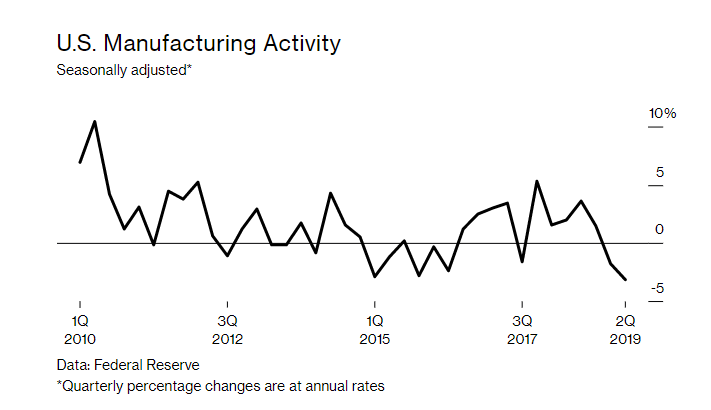A Manufacturing Recession In Key Swing States Could Cost President Trump The 2020 Election
A manufacturing recession could wind up being the Achilles Heel for President Trump in the upcoming 2020 election, says Bloomberg Businessweek.
Greg Petras, President of Kuhn North America, who employs about 600 people at its farm equipment factory in Wisconsin, says that President Trump’s claims of China bearing the brunt of his tariffs are “outright lies”. For Kuhn, the trade war has resulted in rising costs and falling sales.
“You’re slamming your fist on the steering wheel and saying ‘Why would you tell people this?’” Petras said of Trump’s comments.
About 250 of his employees spent their Labor Day weekend in the midst of a 2 week furlough, and they’re facing another one in October. The company’s shrinking order book has meant that is has to cut costs and slash production. For people like Petras, the economy looks “far bleaker from the swing-state heartland than it does in either the White House or on Wall Street,” the report notes.
While the company’s summer picnic survived, its weekend shifts didn’t. Four years ago, the plant was “humming along” to a record $400 million in sales with its sister plant in Kansas running at 50% capacity. This $11 million paint shop, which coats its products in its signature “Kuhn Red” is now at 39% capacity.
The company has had to shelve plans for a $4 million R&D facility. Petras said: “We’ll do it someday. We just need things to be going in a better direction.”
This rounds out a picture of the country’s heartland, where there seems to be a rising tide of evidence that the country is heading for a recession. America’s factories have been hit not only by the trade war, but also by rising uncertainty, a damper on capital expenditures, slowing export markets, a stronger dollar, and higher input costs.
Manufacturing activity measured by August’s ISM number showed the first contraction since 2016, sending stock prices and bond yields tumbling. The last time the country logged two consecutive quarters of contractions was in 2016, when the country lost about 30,000 manufacturing jobs as a result of oil prices collapsing. None of those quarters saw a slump as bad as the 3.1% number that was posted in the second quarter of this year.
And the rise in industrial jobs that President Trump saw his first two years in office has “gone into reverse”. The U.S. added 44,000 manufacturing jobs this year, down from the 170,000 it added during the same period last year.
The number of people working in factories in 22 states – including key states like Wisconsin and Pennsylvania – fell in the first seven months of this year. Trump had campaigned on, and promised, bringing factories back home by unraveling deals like NAFTA and taking on China.
Those promises aren’t likely to have the same effect in 2020 that they did while campaigning in 2016. Trump, on the other hand, continues to believe the ends will justify the means.
“To me, this is much more important than the economy,” Trump said on Sept. 4.
“Somebody had to do this.”
He has called businesses that blame tariffs “badly run and weak” and has tried to force U.S. companies to abandon China. His advisers have argued that blame belongs squarely on the Federal Reserve for hiking interest rates too quickly last year. They also blame the strong dollar for making U.S. exports less competitive.
Trump also points to gains in manufacturing employment during his term. The U.S. has added 485,000 factory jobs since Trump took office, according to Bureau of Labor Statistics data.
But in the swing states, where it will matter to Trump’s 2020 election bid, the news is more grim. Pennsylvania, for instance, lost more than 8,000 manufacturing jobs in the first seven months of this year. And Trump is said to be more exposed politically to a manufacturing downturn than any Democratic rival. Manufacturing accounted for almost 12% of the jobs in counties that voted for Trump in 2016 versus less than 7% for those who supported Clinton.
In battleground states, the difference is even more pronounced: factory jobs accounted for more than 21% of employment there.
Mark Muro, a senior fellow at the Brookings Institution said: “This is the one thing he was going to deliver. And Democrats are not vulnerable at all because if things go south they are not responsible at all.”
Petras, who is a lifelong Republican, says he won’t vote for Trump in 2020. He’s now “expecting to vote for a Democrat”.
“I defaulted to the Republican ticket thinking pro-business,” he said about voting for Trump in 2016. His company has paid $2.5 million more for steel over the last 12 months than it did the year prior. This makes up about 1% of the $250 million in sales he’s expecting for the year. He’ll also pay about $1 million in tariffs this year on about 100 different parts it buys from outside suppliers.
His purchashing manager, Jim Paum, said: “You can tell the health of the economy from these phone calls. For the most part it’s not as healthy as Wall Street thinks.”
“There’s more uncertainty, not less uncertainty,” Petras concluded.
“It’s not a good economy at all.”
You can read Bloomberg’s full longform writeup here.
Tyler Durden
Thu, 09/12/2019 – 18:05
![]()
Zero Hedge’s mission is to widen the scope of financial, economic and political information available to the professional investing public, to skeptically examine and, where necessary, attack the flaccid institution that financial journalism has become, to liberate oppressed knowledge, to provide analysis uninhibited by political constraint and to facilitate information’s unending quest for freedom. Visit https://www.zerohedge.com



